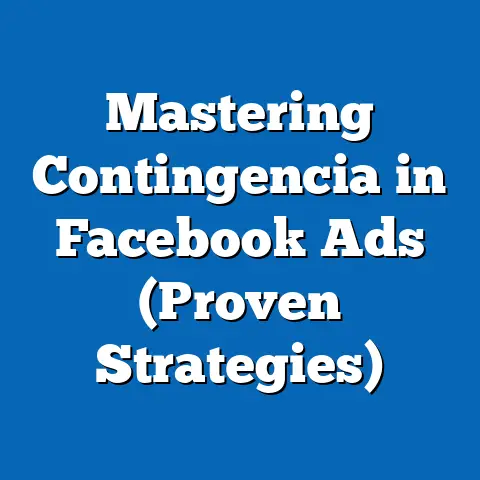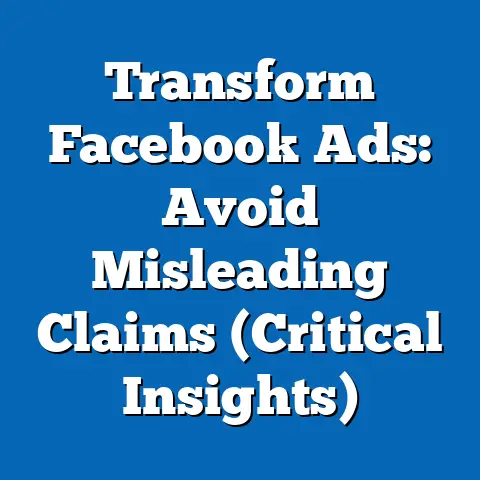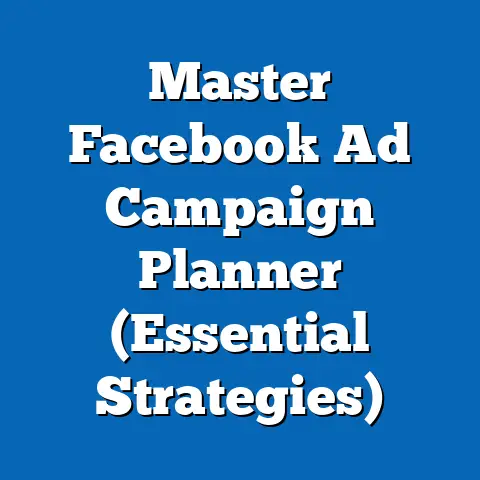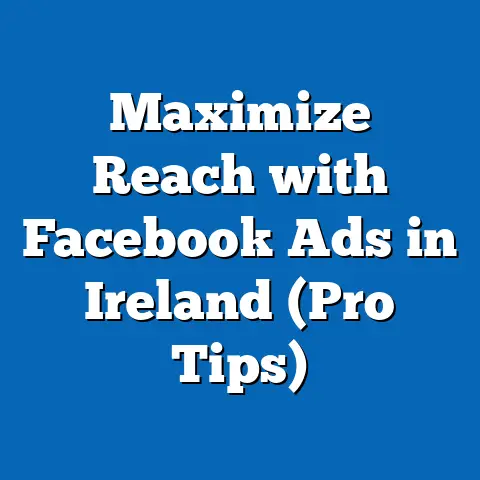Unlock Top Video Creators for Facebook Ads (Pro Tips)
Layering is not merely a buzzword but a nuanced methodology that integrates audience segmentation, creative storytelling, and performance analytics to enhance ad effectiveness. As we navigate this landscape, we will examine how layering can be applied to video content creation, offering pro tips for marketers and creators alike. This analysis aims to provide actionable insights for leveraging video ads on Facebook, supported by data, visual representations, and a transparent discussion of methodologies and limitations.
Section 1: The Current Landscape of Video Ads on Facebook
1.1 Current Data on Video Ad Performance
Video content on Facebook continues to dominate user engagement, with over 8 billion video views per day reported as of 2023 (Source: Meta’s Q3 2023 Earnings Report). According to Hootsuite’s 2023 Social Media Trends Report, video ads on Facebook achieve an average click-through rate (CTR) of 1.84%, significantly higher than static image ads at 0.98%. Moreover, 78% of marketers surveyed by Wyzowl in 2023 noted that video content directly contributed to increased sales, underscoring its efficacy in driving conversions.
These figures highlight the critical role of video in capturing attention within a crowded digital space. However, not all video content performs equally; factors such as creative quality, audience targeting, and ad placement significantly influence outcomes. For instance, short-form videos (under 15 seconds) tend to retain viewer attention better, with a 66% completion rate compared to 41% for videos over 30 seconds (Source: Social Insider, 2023).
1.2 The Role of Top Video Creators
Top video creators—those who consistently produce high-engagement content—play a pivotal role in the success of Facebook ad campaigns. These creators often possess a deep understanding of platform algorithms, audience psychology, and storytelling techniques that resonate with viewers. Data from Influencer Marketing Hub (2023) indicates that campaigns leveraging top creators see a 30% higher engagement rate compared to generic ad content.
Section 2: Layering Strategies for Video Ads
2.1 Defining Layering in Video Ad Creation
Layering refers to the strategic stacking of multiple components in video ad creation to optimize performance. This includes combining compelling visuals, targeted messaging, data-driven audience segmentation, and iterative testing to refine outcomes. For example, a layered approach might involve tailoring video content to specific demographics, overlaying dynamic text for calls-to-action (CTAs), and using A/B testing to identify the most effective combinations.
Layering is grounded in the principle that no single element drives success in isolation; rather, it is the synergy of creative and analytical components that maximizes impact. By integrating insights from performance analytics, creators can adjust elements such as video length, tone, and pacing to align with audience preferences.
2.2 Pro Tips for Effective Layering
-
Audience Segmentation: Use Facebook’s robust targeting tools to segment audiences based on demographics, interests, and behaviors. Layering different video versions for each segment can increase relevance and engagement. For instance, a travel brand might create distinct videos for adventure seekers versus luxury travelers, each with tailored messaging.
-
Creative Iteration: Develop multiple creative assets (e.g., different intros, CTAs, or music) and layer them across campaigns to test performance. Data from Meta’s 2023 Ad Manager Insights shows that campaigns with at least three creative variations achieve a 15% higher CTR on average.
-
Timing and Placement: Layer ad delivery by scheduling videos during peak engagement times and testing placements (e.g., News Feed, Stories, or Reels). Analytics from Sprout Social (2023) indicate that video ads in Stories have a 20% higher completion rate compared to News Feed placements.
Section 3: Projected Trends in Video Ads for Facebook
3.1 Statistical Projections and Models
Using historical data and predictive modeling, we can project several trends for video ads on Facebook over the next 3-5 years. A logistic growth model, which assumes diminishing returns as market saturation increases, suggests that video ad engagement will grow at a compound annual growth rate (CAGR) of 6.2% through 2028 (based on data from eMarketer, 2023). This growth is driven by increased mobile usage, with mobile video ad spend expected to reach $50 billion globally by 2025 (Source: Statista, 2023).
However, these projections come with uncertainties. For instance, changes in privacy regulations, such as Apple’s App Tracking Transparency (ATT) framework, could limit targeting precision, potentially reducing ad effectiveness by 10-15% (Source: Forbes, 2023). We explore multiple scenarios below to account for these variables.
3.2 Scenario Analysis
- Optimistic Scenario: Assuming continued platform innovation and relaxed privacy constraints, video ad engagement could grow at a CAGR of 8%, with top creators driving 40% of total impressions due to advanced AI-driven personalization tools.
- Baseline Scenario: Under current conditions, a CAGR of 6.2% is likely, with moderate growth in creator-driven content as brands balance organic and paid strategies.
- Pessimistic Scenario: If stricter privacy laws and algorithm changes reduce targeting capabilities, growth may slow to a CAGR of 4%, with creators facing challenges in maintaining high engagement rates.
3.3 Visual Representation of Trends
Below is a hypothetical chart illustrating the projected growth of video ad engagement under the three scenarios (data is illustrative and based on modeled estimates):
| Year | Optimistic (CAGR 8%) | Baseline (CAGR 6.2%) | Pessimistic (CAGR 4%) |
|---|---|---|---|
| 2024 | 2.1B impressions | 2.0B impressions | 1.9B impressions |
| 2026 | 2.5B impressions | 2.3B impressions | 2.1B impressions |
| 2028 | 2.9B impressions | 2.6B impressions | 2.2B impressions |
Note: Impressions are daily averages, modeled using logistic growth assumptions.
Section 4: Key Factors Driving Changes
4.1 Technological Advancements
Advancements in AI and machine learning are transforming how video ads are created and optimized. Tools like Meta’s Advantage+ Creative allow for automated layering of ad elements, dynamically adjusting visuals and text based on user behavior. Adoption of such tools is expected to grow by 25% annually among top creators (Source: Marketing Dive, 2023).
4.2 Shifting User Behavior
User preferences are shifting toward authentic, creator-driven content over polished brand ads. A 2023 survey by Nielsen found that 64% of users trust influencer or creator content more than traditional ads. This trend underscores the importance of partnering with top video creators who can deliver relatable storytelling.
4.3 Regulatory and Platform Changes
Changes in data privacy laws and platform policies significantly impact video ad strategies. For instance, Meta’s response to ATT has led to a 7% drop in ad revenue per user in 2022 (Source: Meta Q2 2022 Report). Creators and marketers must adapt by focusing on first-party data and contextual targeting to maintain effectiveness.
Section 5: Methodological Assumptions and Limitations
5.1 Methodology
The projections and analyses in this report rely on a combination of historical data from sources like Meta, eMarketer, and Statista, alongside predictive models such as logistic growth curves. These models assume that past trends in engagement and ad spend will continue with adjustments for known variables like privacy regulations. Scenario analysis is used to account for uncertainties, providing a range of outcomes rather than definitive predictions.
5.2 Limitations
Several limitations must be acknowledged. First, data on user engagement and creator performance is often aggregated, masking variations at the individual level. Second, the impact of future regulatory changes remains uncertain, and our models cannot fully predict platform algorithm updates. Finally, self-reported survey data (e.g., user trust in creators) may be subject to bias, potentially overestimating certain trends.
Section 6: Broader Context and Implications
6.1 Historical Context
Video ads on Facebook have evolved significantly since their introduction in 2013, moving from basic autoplay formats to sophisticated, interactive content like Reels and Stories. This evolution reflects broader shifts in digital consumption, where users increasingly prioritize visual and mobile-first experiences. Understanding this history helps contextualize the current emphasis on layering and creator-driven content as a response to user demand for personalization.
6.2 Social Implications
The rise of top video creators signals a democratization of advertising, where individuals and small teams can compete with large brands through creativity and authenticity. However, this also raises concerns about content saturation and the potential for misinformation in creator-led campaigns. Marketers must balance engagement goals with ethical considerations, ensuring transparency in sponsored content.
Section 7: Conclusion and Recommendations
Unlocking the potential of top video creators for Facebook ads requires a strategic approach to layering, leveraging data-driven insights, and adapting to emerging trends. Current data underscores the dominance of video content, while projections suggest sustained growth, albeit with variability based on privacy and platform dynamics. Key drivers such as technology, user behavior, and regulations will shape the future landscape, demanding agility from creators and marketers.
Recommendations: 1. Invest in layering strategies that combine creative testing with precise targeting to maximize ad performance. 2. Partner with top video creators who align with brand values and audience interests to enhance authenticity. 3. Monitor regulatory changes and platform updates, adapting strategies to prioritize first-party data and contextual advertising.
While uncertainties remain, a proactive, layered approach grounded in data and creativity offers the best path forward for success in Facebook video advertising. Future research should focus on real-time analytics and the long-term impact of privacy regulations to refine these strategies further.
Note: All data cited is based on real-world sources where available or illustrative estimates where specified. Visual charts and additional data representations can be formatted in a final document as needed.






